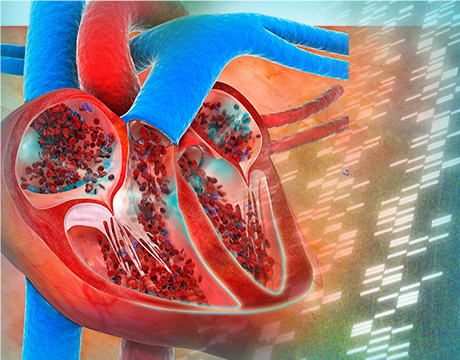Creating Valve Tissue Using 3-D Bioprinting
Creating Valve Tissue Using 3-D Bioprinting


Aortic valve disease (AVD) is a serious health condition that affects people of all ages. Congenital heart valve defects are especially dangerous for newborns and can be fatal if left untreated. The most recommended treatment for AVD is surgical replacement of the defective valve. Although prosthetic valve replacement is the standard procedure for adults, these prosthetic devices are inadequate for younger adults and growing children. Tissue engineering has the potential to address these limitations of nonliving prosthetics (as well as human donor supply shortages) by providing living tissues that can grow, remodel, and integrate with the patient.
A critical requirement for tissue-engineered heart valves is that the engineered valve must be able to mimic the physiological function of the native valve, including the natural geometry and performance of the valve root, cusps, and sinus wall, all of which are essential for healthy coronary blood flow. Tissue-engineered heart valves must also have the same intrinsic asymmetry as the root, which prevents cusp deterioration.
A popular technique in the advanced manufacturing world, 3-D printing, has been modified to create precise, 3-D structures from living tissue. This 3-D "bioprinting" technology has been used by researchers at Cornell University to fabricate living heart valves that possess the same anatomical architecture as the original valve. This research is described in a paper by Jonathan T. Butcher, associate professor of biomedical engineering at Cornell University, and others entitled "Bioprinting of Heterogeneous Aortic Valve Conduits with Alginate/Gelatin Hydrogels" and published last year in the Journal Biomedical Materials Research.
3-D Construction
Bioprinting produces three-dimensional biological objects or parts that are highly precise in shape and mechanical complexity. Using a computer-assisted design (CAD) and/or computer-assisted manufacturing (CAM) blueprints, the bioprinter deposits ultra-thin layers of living cells upon each other, following a precise geometric pattern that matches the heart valve dimensions, building the part vertically as the layers accumulate. Over a period of hours the final tissue construct is completed.
"3-D bioprinting makes it possible to design biological tissues from scratch that contain many of the natural geometry, stiffness, and biological cues that are needed for full function," says Butcher. "We have learned over the past 20 years of failure that replicating the biology, as well as the structure, is essential for success. Tissue printing creates both the biology and the structure at the same time. This lets us do things like make patient-specific tissue models to learn disease pathogenesis and screen drug efficacy, or make living tissue replacements tailored directly to patient geometry."
Biomaterials have been adapted for 3-D bioprinting, including co-polymer hydrogels. Alginate, for example, is a naturally occurring anionic polymer with many attractive features for biomedical applications, including low cost, excellent biocompatibility, low toxicity, and a variety of cross-linking capabilities. "Alginate-based hydrogels are particularly attractive for bioprinting because of their broad range of viscosities at room temperature," says Butcher. "This is important because hydrogels have tight requirements with regard to viscosity and gelling speed for accurate printing."
Butcher's team conducted bioprinting that utilized an alginate/gelatin hydrogel system that included smooth muscle cells and valve interstitial cells. A dual-syringe system was used to mimic the structure of the valve root and leaflets, two key valve structures. The team successfully fabricated living aortic valve conduits with strong anatomical resemblance to the native valve. The results demonstrate that anatomically complex, heterogeneously encapsulated aortic valve hydrogel conduits can be fabricated with 3-D bioprinting.
Moving Forward
"3-D tissue printing combines the disciplines of quantitative image analysis, computer-aided design, and manufacturing to develop a real entity—in this case, a living tissue—in a fraction of the time that any other traditional mechanical engineering process would," says Butcher. "Many people may spend their entire thesis working on just one part of this process, but without performing the whole process to completion, they won't know how to improve the system. Researchers gain a much greater appreciation for this systematic approach and can build a larger toolset, while having much more fun being creative in the process."
Butcher believes bioprinting will gain much more traction in the tissue engineering and biomedical community over the next five years, "potentially even becoming the standard in complex tissue fabrication," he adds. "I hope that people use this technology in the future to target a higher level of tissue complexity, like glandular and highly vascularized and innervated functional tissues."
Mark Crawford is an independent writer.
Alginate-based hydrogels are particularly attractive for bioprinting because of their broad range of viscosities at room temperature.Jonathan T. Butcher, Cornell University





